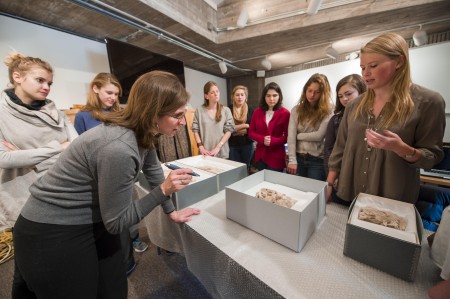When art and art history professor Elizabeth Marlowe stumbled upon 20 large limestone figural reliefs in the collection of Colgate’s Picker Art Gallery, it was a momentous research opportunity, not just for Marlowe but also for 15 students in her Seminar in Art Prior to 1300 — New Egyptian Reliefs in the Picker: Challenges and Opportunities.
While trying to reconstruct the age and authenticity of the objects — and the circumstances under which they might have left Egypt — the students are, as the syllabus promised, “engaging with the same thorny ethical and theoretical issues that curators, dealers, collectors, and scholars do when confronting new (or newly discovered) work of art.”
When the semester began, all that was known about the works was that Herbert Mayer, a renowned collector of modern art, purchased them in the 1960s in Egypt and that he later bequeathed them to Colgate.
So Marlowe framed the course around a series of original research questions whose answers were impossible to predict. Rather than requiring the 20-page research paper that is typical of a 400-level course, she has reviewed her students’ research notebooks throughout the semester. She said, “I will give them credit for following all of their leads, regardless of where they end up.”
Caroline Lee ’13 spent a day over spring break in the Archives of American Art in Washington, D.C., reviewing the records of Mayer’s World Houses Galleries.
“I am trying to figure out how the reliefs at the Picker Gallery fit into Mayer’s larger collection,” said Lee. “It is difficult to figure out why Mayer would have purchased ancient reliefs, as the World House Galleries is focused on international modernism.”
Eliza Graham ’14 took a trip to the Brooklyn Museum of Art to interview the curator of a 2009 exhibit there that showed “authentic” late Antique Egyptian reliefs alongside others she believed to be forgeries.
“Methods for spotting fake works is such an interesting and relevant topic in the art world,” Graham said. “One must be skeptical and not believe that every work is real just because someone in a position of power says it is.”
And for Marlowe — who is at work on a book called Shaky Ground: Context, Connoisseurship and the History of Roman Art — that is the crux of the matter. “Rather than trying to figure out when and where the reliefs were made, and what does the iconography signify, my book is about the basic unanswerability of those questions when something is discovered on the art market.”
Hear Marlowe talk about discovering the reliefs in the video below.
Read the story of Marlowe’s discovery and subsequent petro-graphic chemical analysis by chemistry laboratory instructor Patricia Jue in the Colgate Maroon News.
Want to learn more? Watch the full (11-minute) video.

